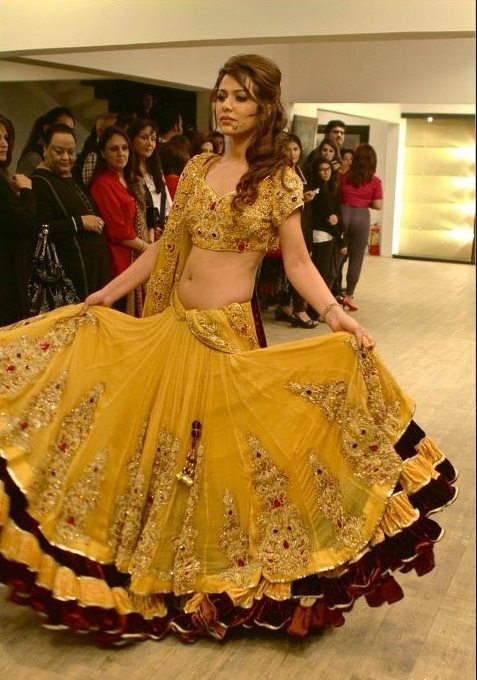Pakistani Wedding Dresses Dresses Suits Mehndi Designs Pic Jewellery Mehndi Lehengas 2013
Source: google.com.pk
Weadding Dresses History and New Century
The 1970s
Sleeves were the big feature of seventies dresses. After twenty years of tight sleeves cut to a point over the hand, Princess Anne led the way with her extravagant Tudor sleeved wedding gown, and the brides of this decade followed suit with sleeve styles culled from every era. The shape of the dress itself moved gradually from the narrow, high-waisted empire line of the late 1960s to the more flared princess line, with little or no train, and the waist gradually fell to its natural position by 1980. Pinafore styles were very popular, whether actually two layered, or just giving the effect with a contrasting sleeve and bib front.
These two brides are both wearing gowns typical of the mid-seventies, made from the same Simplicity Pattern 6940. When Trudy Pope (left) married Stephen Hutchings in May 1976, she added a scooped neckline and bishop sleeves to the slightly high-waisted princess line gown. She carried white tulips. When Elizabeth Locking (right) married Edward Davies in December of the same year, she also made the dress up in satin, bought from Hart's of Wigan for £6.40, but chose the high neckline and the multi-caped sleeves. She carried bronze chrysanthemums in imitation of her grandmother Elsie Pennell fifty years before, and attached to her Juliet cap wore a hand crocheted veil made by Elsie.
The 1980s
If Princess Anne's wedding dress influenced the seventies bride, the Princess of Wales' extravagant skirt and huge sleeves proved the style icon of the 1980's. After the restrained outlines of the previous decade, every bride now wanted a fairytale crinoline and tiara. Waistlines had already returned to their natural position. When Glynnis Davies (right) married Thomas Barnes in 1979, skirts had already begun to get fuller, but this was still flare, not gather. Glynnis's gown was of nylon ribbon lace, and had a wide spreading train. Her veil was attached to the back of her matching headband, and she carried yellow roses. After Diana's dress, everyone had full skirts gathered to the waist, and big sleeves to the elbow, with flounces and bows and lace embellishments. There was a surge in popularity for taffeta and silk. Her flowers also signalled a return of the big bouquet, with trailing greenery. However, it soon became clear that what looked wonderful on a 5'10" slender princess, did not always suit short miss average. So when Sarah Ferguson modified the look to suit her fuller figure, with a low waistline, pointed at front and back, and flare as well as gather in her satin skirts, other brides soon followed her, and set the style that was to prevail for the next few years.
The 1990s
Applied embroidery and beading, on a fairly stiffly sculpted satin corsetted bodice, with important sleeves, had become very much the norm. A variation was introduced with off the shoulder designs derived from mid or late victorian evening wear, such as that worn by Nicola Holmes (left) in 1990. As the decade progressed, a variety of skirt choices became available. The wide skirt stayed popular, but then a variant which had a very dropped waist, to below the hip, and then flared, was often seen. Gradually, more fluid materials began to appear alongside the stiffly appliqued fabrics, and narrower profiles returned, as worn by Lady Sarah Armstrong-Jones when she married Daniel Chatto in 1994, wearing draped georgette under a ruched corset. As the nineties progressed, shift dresses were introduced in day wear fashions, often made by layering a fine fabric over a lining for an ethereal effect, and this trend soon appeared on the bridal scene too. This was the look epitomised by Sophie Rhys-Jones when she married Prince Edward in 1999, wearing a floating organza coat, edged with a deep pearl and glass beaded border, over a body-skimming silk crepe dress.
A NEW CENTURY
We have now reached a new century, and no doubt the wedding gown will carry on changing in fabric and altering in form. But there is equally no doubt that it will remain with us. Since the civil wedding laws were relaxed in the 1990s, allowing marriages to be conducted almost anywhere, even those with no religious convictions can have a beautiful setting for a full-rig "do". As wedding fashion continues to evolve separately from the general vogue, people have felt freer to allow full rein for their imaginations, and some wedding parties are not so much in "best" dress as fancy dress, as themed and fantasy costumes are the order of the day. Which all goes to prove that everyone likes to dress up now and again, and every girl wants her day in the sun.










No comments:
Post a Comment